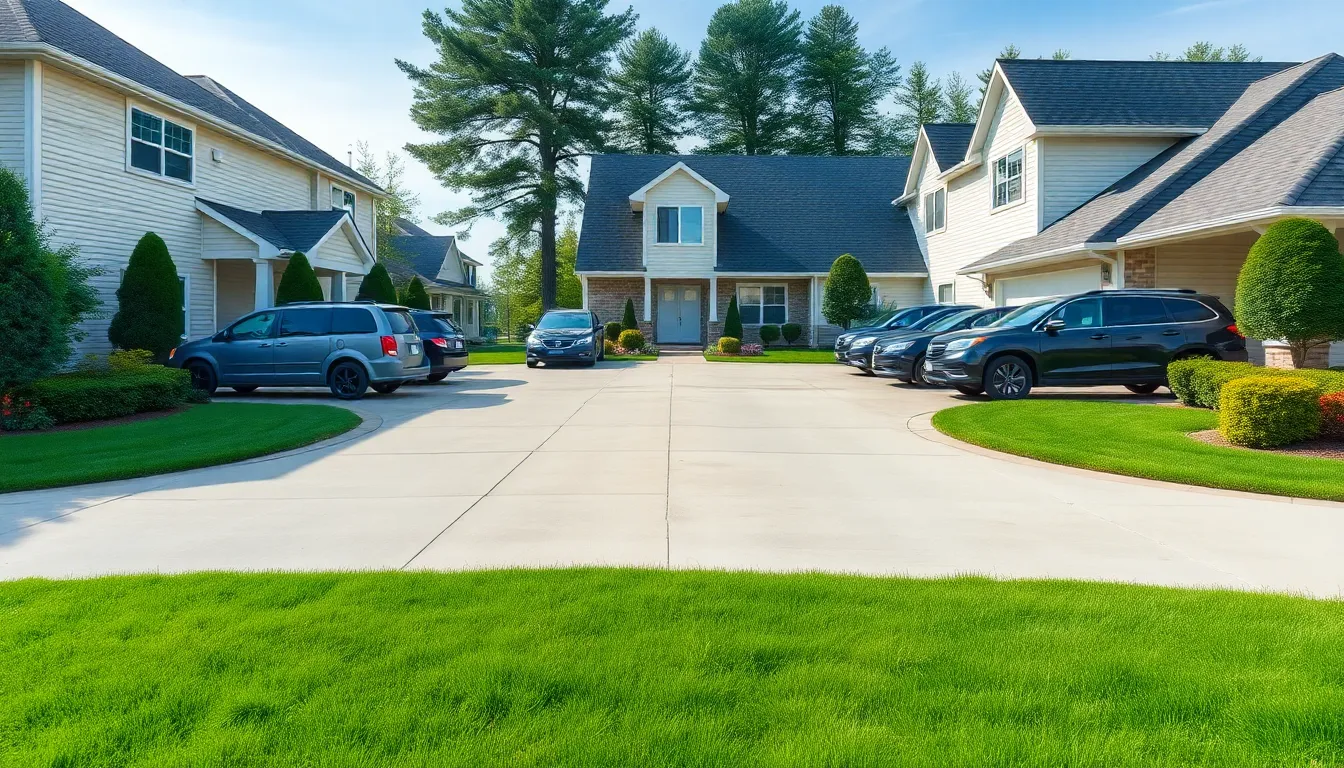When it comes to driveways, width matters—just ask anyone who’s tried to squeeze a minivan into a space meant for a compact car. A driveway that’s too narrow can turn a simple task into a game of automotive Tetris, leaving drivers sweating and wishing for a magic wand. Finding the right width isn’t just about fitting in; it’s about making a statement.
Imagine hosting a barbecue and watching your guests navigate a tight squeeze while trying to park. It’s a recipe for awkward moments and potential fender benders. A well-planned driveway width not only enhances curb appeal but also ensures everyone can park without performing a three-point turn worthy of a driving exam. Let’s dive into why driveway width is crucial for functionality and style, ensuring your home is as welcoming as it is practical.
Table of Contents
ToggleImportance Of Driveway Width
Driveway width significantly impacts the functionality of a property. Adequate width ensures that vehicles can maneuver easily, reducing the risk of damage to both the vehicle and the property. Homeowners often find that a wider driveway allows better parking options, especially for larger vehicles like SUVs or trucks.
Narrow driveways can lead to tight parking conditions, making it challenging to enter or exit vehicles. Maneuvering through constrained spaces increases the likelihood of accidents or property damage. A proper width accommodates multiple cars, facilitating guest parking while enhancing overall convenience.
Curb appeal improves with a well-designed driveway. A spacious driveway creates an inviting atmosphere, making the home more attractive. Buyers consider driveway width when evaluating properties, as it reflects practical aspects of the home.
Specific guidelines suggest that a single-car driveway should measure at least 10 to 12 feet wide. For two cars, a width of 20 to 24 feet proves optimal, providing adequate space for comfortable parking and movement. Some local regulations might require specific measurements to meet zoning laws, underscoring the importance of checking local guidelines.
Wider driveways can also feature additional landscaping options, contributing to aesthetic appeal. Integrating decorative elements like borders or pathways alongside a broader driveway enhances the overall look of the property.
Consideration of driveway width before construction or renovation leads to significant long-term benefits. Proper planning allows space for growth, accommodating future vehicles or changes in the household. Making informed decisions enhances both function and appearance, ensuring that the driveway meets all necessary needs.
Factors To Consider When Determining Driveway Width

Determining the right driveway width involves several crucial factors. These factors ensure optimal functionality and adherence to local standards.
Vehicle Size
Vehicle size plays a significant role in driveway width decisions. Larger vehicles like SUVs and trucks require more space for maneuvering and parking. A minimum width of 10 to 12 feet serves well for small cars, while 20 to 24 feet is recommended for two vehicles side by side. Consider the vehicles owned and those that may be used in the future. Wider driveways can accommodate guests’ vehicles, reducing parking challenges.
Traffic Volume
Traffic volume influences driveway width requirements. High-traffic areas necessitate wider driveways to facilitate easier entry and exit. If multiple cars regularly use the driveway, a broader width ensures safety and convenience. By providing enough space, drivers can navigate without obstruction or risk of accidents. Analyze peak traffic times and frequency of guests to determine the ideal width for individual needs.
Local Regulations
Local regulations dictate minimum standards for driveway widths. Guidelines can vary, so it’s essential to consult local building codes before construction. Compliance helps avoid potential fines and ensures proper drainage and access. Many jurisdictions recommend at least 10 feet for single-car driveways and 20 feet for two-car widths. Always verify local zoning laws to ensure conformity with community standards and safety requirements.
Recommended Driveway Widths
Choosing the right driveway width matters for functionality and convenience. Specific measurements based on use can enhance the user experience and ensure smooth vehicle movement.
Residential Driveways
Residential driveways typically require a width of 10 to 12 feet for a single vehicle. This width supports comfortable entry and exit, allowing for easy maneuvering. A two-car driveway should measure between 20 and 24 feet, accommodating two vehicles side by side. Wider driveways also enhance accessibility for larger vehicles, such as SUVs and trucks. Homeowners often find it beneficial to create additional space for guests or family members, reducing parking challenges. It’s essential to check local regulations, as they may dictate minimum width requirements for residential properties.
Commercial Driveways
For commercial properties, recommended driveway widths often range from 15 to 20 feet for single-lane access. These dimensions facilitate the movement of delivery trucks and larger vehicles. A two-lane commercial driveway typically spans 24 to 30 feet, allowing for safe passage in busy environments. High-traffic areas frequently necessitate wider driveways to accommodate frequent vehicle flow and ensure safety. Local zoning ordinances may enforce specifications, so verifying requirements is crucial. Adequate width in commercial driveways not only improves functionality but also enhances the overall experience for customers.
Common Mistakes In Driveway Width Planning
Planning the driveway width often involves common pitfalls that can lead to inefficiencies. Prioritizing appearance over functionality frequently results in inadequate space for vehicles. Homeowners sometimes underestimate the necessary width required for larger vehicles, creating challenges for parking and maneuvering. Ignoring local regulations may also result in non-compliance, leading to fines or the need for costly adjustments.
Inadequate consideration of traffic volume can hinder accessibility. Areas with frequent vehicle movement require a wider design for safe navigation, especially when accommodating guests. Often, individuals focus solely on the primary vehicle, neglecting the potential need for multiple vehicles or larger guests’ cars. This oversight can create parking issues, especially during gatherings.
Not reviewing the dimensions of neighboring driveways might lead to inconsistencies that can impact curb appeal. Overly narrow driveways can create an uninviting aesthetic, detracting from the overall property value. Additionally, failing to take into account future needs can result in long-term dissatisfaction. Homeowners may find themselves with inadequate space as family dynamics or vehicle sizes change.
Planning for parking limits can also lead to frustration. Driveways that only accommodate one vehicle can negatively impact a household with multiple drivers. Not measuring the available space correctly can restrict options for redesign or expansion later. Mistakes in layout can impede drainage, leading to water pooling issues that may damage vehicles or property.
Addressing these mistakes during the design phase ensures a smoother process and safer use of the driveway. Making informed, comprehensive decisions about driveway width impacts both immediate functionality and long-term value.
A well-planned driveway width is crucial for enhancing both functionality and aesthetics. It not only improves parking ease for residents and guests but also boosts curb appeal. By adhering to recommended width guidelines and considering factors like vehicle size and traffic volume, homeowners can avoid common pitfalls.
Taking the time to assess local regulations ensures compliance and helps prevent costly adjustments down the line. Ultimately, investing in the right driveway width pays off in convenience and safety, making it a vital aspect of property planning.





